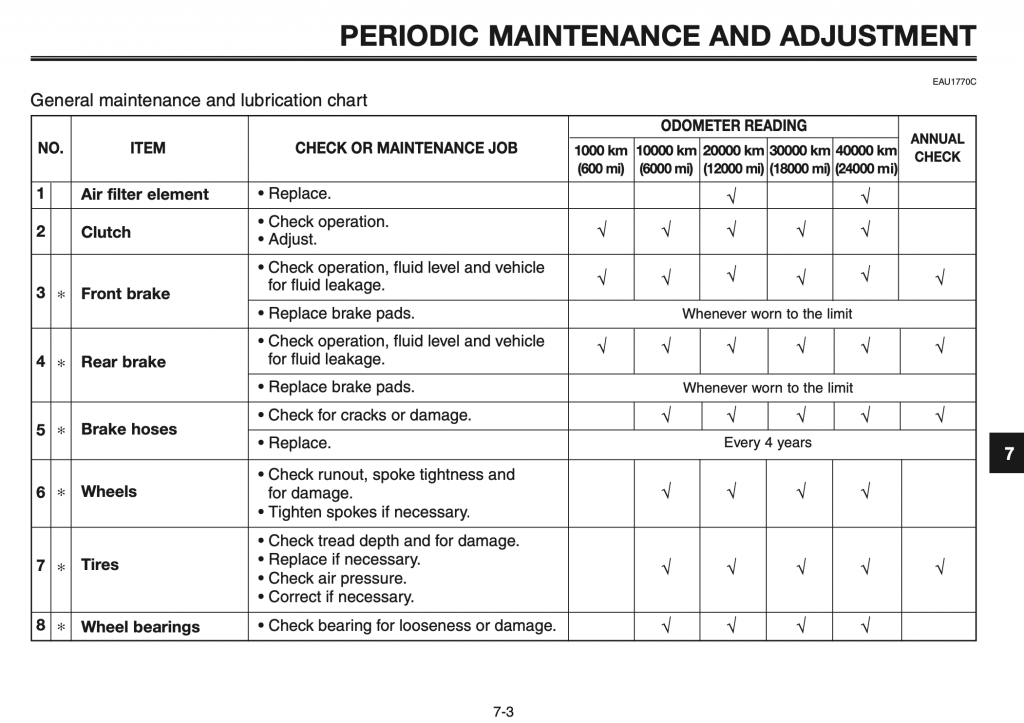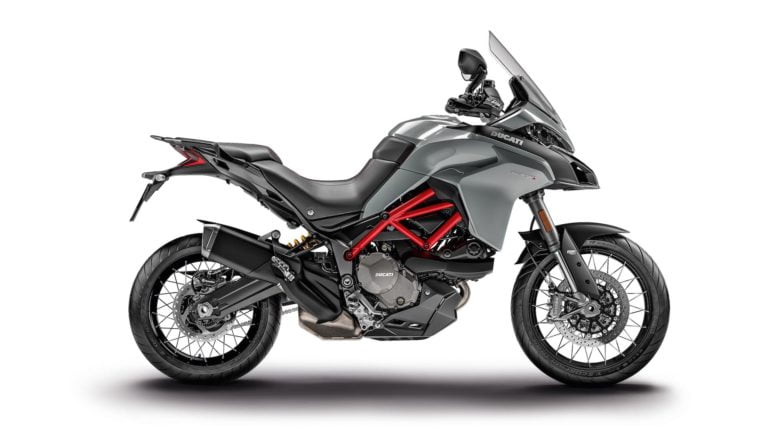Yamaha XT660Z Ténéré (2009-2015) Maintenance Schedule
The Yamaha XT660Z Ténéré (a.k.a. the XTZ660) is a big-bore adventure bike/dual sport with a modern fuel-injected “thumper” engine.
The XT660Z Ténéré is part of the XT660 range of motorcycles that all share the same underlying platform, a four-stroke four-valve single-cylinder 659cc liquid-cooled fuel-injected engine. It is reliable, torque-rich, and very practical for short or long-haul riding.
The three variants in the XT660 range are:
- XT660R: The base model dual-sport. 21/17 inch tyres front and back, with a single 298 mm front brake disc.
- XT660X: The street-oriented supermoto. Bigger (still single) front disc (320mm), and 17-inch tyres front and back.
- XT660Z Ténéré: 21/17 tyres (as with the base model), dual 298mm discs, long-range fuel tank (22L vs 15L in the other models), taller cowl, hand guards, engine guards, skid plate, vertically stacked bulbs.
So the XT660Z is the highest spec of all of them, but maintenance for all of them (other than brakes and tyres) is the same.
In 2018, the Yamaha XT660Z Ténéré was replaced with the Yamaha XTZ690 Ténéré 700, based on the CP2 engine from the Yamaha MT-07.
This site has links for things like oil and spark plugs from which we earn a commission (which unfortunately nobody can save, not even us). If you appreciate this work, then please use those links. Thanks!
Yamaha XT660Z Ténéré Service Intervals
Basic service intervals for the Yamaha XT660Z Ténéré are ever 10000 km or year, when you should change the oil, do a full inspection and check the spark plug.
The valve service interval on the XT660Z Ténéré is every two services — 20000 km or 12000 miles. Change the air filter at the same time.
Also, make sure to keep your liquids fresh, regularly changing the coolant and the brake fluid.
What you need to service your Yamaha XT660Z Ténéré
Servicing a fuel injected thumper is as easy as it gets. You just have one cylinder, and no carbs! You need some basic maintenance tools (you won’t need a rear stand if you already have a centre stand) and away you go.
Some parts are common to all XT660 motorcycles, but the brakes and tyres are different.
| Part | Yamaha XT660Z spec |
|---|---|
| Engine oil | The manual recommends SAE 10W30, 10W40, 15W40, 20W40, or 20W50 engine oil meeting API service SE, SF, SG or higher. This means a lot of motorcycle oils fit the mark. Yamalube 10W40 is an excellent choice — on brand, and cheap. |
| Oil filter | Standard part number is 4X7134409000. Use a Hiflofiltro HF145, which fits many models. |
| Spark plug | Manual calls for NGK CR7E. |
| Air filter | Use a K&N air filter YA-6608 which is more available and very high quality. |
| Brakes | The XT660Z has twin discs up front and one disc in the rear. EBC’s R brake pads provide good performance for this bike. Use 2 x FA172R up front, and 2 x FA101R in the rear. |
| Grease | Grease external pivot points (e.g. the swingarm shaft) with lithium soap-based grease. |
| Chain | Maintain your chain — Motul chain paste is a low-cost and mess-free way of doing it |
| Coolant | The manual doesn’t specify, but normally Japanese motorcycles use ethylene glycol-based coolant that’s silicate and borate-free to preserve the life of aluminium components. I like Honda Coolant as an effective long-life coolant. |
Maintenance schedule for the Yamaha XT660 motorcycles
Below is the maintenance schedule for the Yamaha XT660 motorcycles.
It’s broken up into two parts:
- The periodic service schedule, and
- The standard list of things to check at every service
Periodic service schedule
Notes
- Past the end of the maintenance schedule, repeat it in the interval shown
- Where there’s a time-based interval and a distance-based one, follow th earlier of the two.
| km x 1000 | 10 | 20 | 30 | 40 | |
|---|---|---|---|---|---|
| mi x 1000 | 6 | 12 | 18 | 24 | Other |
| Perform full standard inspection checklist (see below) | ✓ | ✓ | ✓ | ✓ | Annual (Where relevant) |
| Engine oil — Change (Yamalube 10W-40) | ✓ | ✓ | ✓ | ✓ | Annual |
| Engine oil filter — Replace (HF204RC) | ✓ | ✓ | |||
| Spark plug — Check condition. Clean and regap (Spark plug gapping tool) | ✓ | ✓ | |||
| Spark plug — Replace (CR7E) | ✓ | ✓ | |||
| Valves — Check valve clearance. Adjust as necessary | ✓ | ✓ | |||
| Air filter — Replace (YA-6608) | ✓ | ✓ | |||
| Brake fluid | 2 years | ||||
| Brake hoses — Replace | 4 years | ||||
| Steering bearings — Lubricate with lithium soap-based grease | 20000 km (12000 mi) | ||||
| Swingarm — Lubricate with lithium soap-based grease | 50000 km (30000 mi) | ||||
| Cooling system — Change coolant (Ethylene glycol-based coolant) | 3 years |
Standard inspection checklist
Below is the standard inspection checklist for the Yamaha XT660 motorcycles. Note the column “Annual”. Do these items even if you haven’t done the distance.
| Yamaha XT660 Standard Service Inspection Checklist | Annual |
|---|---|
| Fuel lines — Check fuel hoses for cracks or damage | Yes |
| Fuel injection — Adjust engine idling speed | Yes |
| Engine oil — Check oil level and vehicle for oil leakage | Yes |
| Front brake — Check operation, fluid level, and vehicle for fluid leakage | Yes |
| Rear brake — Check operation, fluid level, and vehicle for fluid leakage | Yes |
| Brake pads — Check for wear. Replace when worn to limit. | Yes |
| Brake hoses — Check for cracks or damage. Check for correct routing and clamping. | Yes |
| Brake lever pivot shaft — Lubricate with silicone grease | Yes |
| Brake pedal pivot shaft — Lubricate with silicone grease | Yes |
| Front and rear brake switches — Check operation | Yes |
| Clutch — Check operation. Adjust as necessary | |
| Clutch lever pivot shaft — Lubricate with lithium soap-based grease | Yes |
| Cooling system — Check coolant level and vehicle for coolant leakage | Yes |
| Throttle grip — Check operation. Check throttle grip free play, and adjust if necessary. Lubricate cable and grip housing (Protect all cable life). | Yes |
| Tires — Check tread depth and for damage. Replace if necessary. Check air pressure, Correct if necessary. | Yes |
| Wheels — Check runout, spoke tightness, and for damage. Tighten spokes if necessary. | |
| Wheel bearings — Check bearings for looseness or damage | |
| Steering bearings — Check bearing play and steering for roughness | |
| Front fork — Check operation and for leakage | |
| Swingarm — Check operation and for excessive play | |
| Shock absorber — Check operation and for leackage | |
| Rear suspension relay arm and connecting arm pivot points — Check operation | |
| Air induction system — Check the air cut-off valve, reed valve, and hose for damage. Replace any damaged parts if necessary. | Yes |
| Sidestand — Check condition. Lubricate with lithium soap-based grease as needed. | Yes |
| Sidestand switch — Check operation | Yes |
| Moving parts and cables — Lubricate (Protect all cable life) | Yes |
| Chassis fasteners — Make sure that all nuts, bolts, and screws are properly tightened. | Yes |
| Lights, signals, and switches — Check operation. Adjust headlight beam. | Yes |
| Mufflers and exhaust pipes — Check the screw clamps for looseness |
Maintaining Your Chain on the Yamaha XT660
It’s important to maintain your chain on the XT660, as on any chain-driven motorcycle. Use a good-quality chain lubricant like Motul chain paste, or a Motul chain care kit which comes with a couple of handy tools to maintain the chain.
Yamaha recommends you follow the following chain maintenance schedule every 500 km / 300 mi km and after washing the motorcycle, riding in the rain, or riding in wet areas.
| Chain maintenance item |
|---|
| Check drive chain lubrication condition, lubricating if necessary (Motul chain paste) |
| Check drive chain slack, alignment, and condition, adjusting / replacing if necessary |
Naturally, if you track or race your XT660, then attend to your chain more often.
Tyre/Wheel size for the Yamaha XT660Z Ténéré
The Ténéré has bigger tyres/wheels than the supermoto, though the same as the XT660R. Here are its tyre and wheel sizes, as well as recommended pressures. Of course, find the best pressure for you, based on your characteristics, riding style, and where you are riding. Off-road, Yamaha recommends 200 kPa (29 psi) front and rear.
| Wheel | Tyre size | Tyre pressure |
|---|---|---|
| Front | 90/90-21 M/C 54S | 30-33 psi |
| Rear | 130/80-17 M/C 65S | 33-36 psi |
Non-ABS models ship with Michelin Sirac or Metzeler Tourance tyres. The ABS model ships with Pirelli Scorpions.
About the Yamaha XT660Z Ténéré

The Yamaha XT660Z Ténéré straddles the classes of “dual sport” and “adventure tourer”. It is built around the platform of the XT660R, but has better braking and a bunch of options (like a longer-range fuel tank and better weather protection) to make it more suitable for the long road.
The XT660Z also gets a dual-bulb headlamp assembly with a vertically stacked low and high beam. It looks cool, and keeps the front narrow for better aerodynamics. There’s also an optional centre stand, very useful for long trips to oil the chain or repair a wheel.
The base engine is the same four-stroke four-valve single-cylinder 659cc water-cooled fuel-injected engine. It is reliable, torquey, very practical, and easy to maintain (just one cylinder!). Power is put to the ground via a 5-speed transmission and a chain drive — so you’ll have to clean that chain regularly if (when) you head off-road.
What makes the XT660Z Ténéré unique among Japanese thumpers is that it is a more advanced motorcycle. It’s fuel-injected and it has had ABS brakes as an option for many years — something that the Japanese thumpers never got (until the 2022 KLR650, anyway). BMW did with its F650GS though.
Aside from that, the XT660Z is a real looker. The style didn’t even change dramatically with the XTZ690 Ténéré 700.
The XT660Z has moderately long-travel suspension (210mm of travel). It’s not like a motocross bike, but it’s ample for winding, dusty roads in the middle of nowhere.
The XT660Z Ténéré could also be considered the little sibling of the much bigger and heavier XTZ1200 Super Ténéré which has a large bore parallel twin engine and a shaft drive. In fact, the Ténéré name has been with Yamaha for decades.
Manual for the Yamaha XT660Z

The above maintenance table came from the manual for the XT660Z. It’s available from some regional Yamaha websites, like the one in Europe or in Australia (click on “Owners Manuals”).









